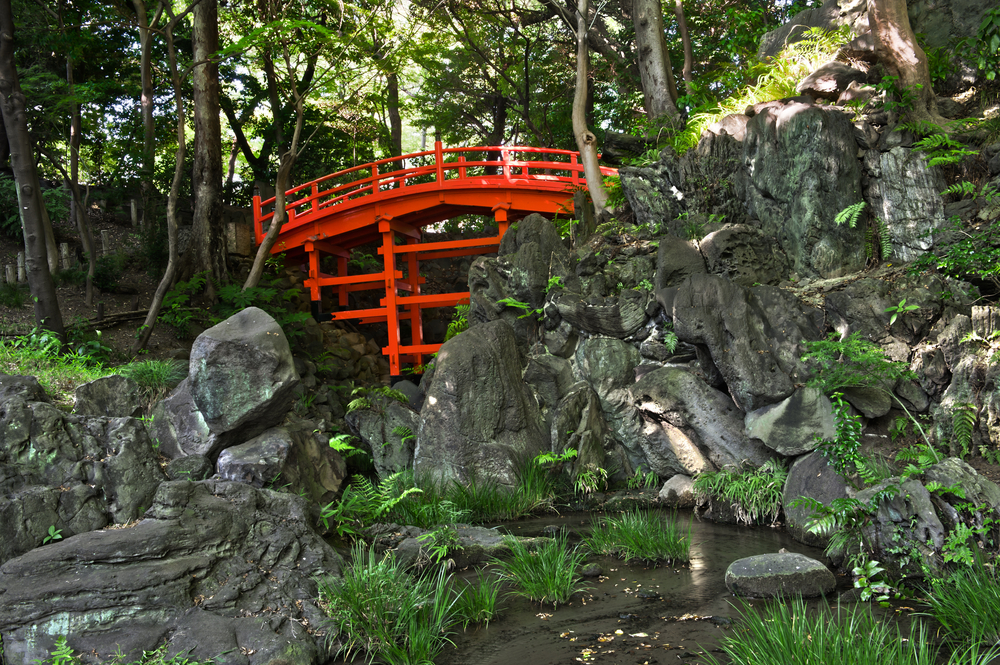The 3 Japanese gardens of Tokyo
When we think of Tokyo, we instantly picture a city of skyscrapers, crazy rhythm and always full of people. Yet, the megalopolis is home to three of the Japanese government-designated gardens as national heritage, or if one literally translates the term used: Location with special beauty (特別名勝). For those who will need peace and nature after several days of sightseeing in the hectic pace of the megalopolis here is the list of the three most famous Japanese gardens in Tokyo:

The Tsutenkyo Bridge in the Koishikawa Korakuen Garden
- The Koishikawa Korakuen Garden:
The garden is located close to the Tokyo Dome and its amusement park, that is to say two steps away from an extreme modernity. Yet there is a calm atmosphere typical of traditional Japanese gardens. It is the oldest garden in Tokyo, since its construction began in 1629 under the initiative of Yorifusa Mito but was completed only by his successor Mitsukuni Mito. Like many Japanese gardens, several famous places are reproduced in miniature, like Lake Biwa, symbolized by the central pond. The garden is beautiful all year round, from cherry blossoms in spring to Japanese maples in autumn. There is in particular a "full moon bridge" (Engetsukyo) which by its shape, creates a perfectly round circle when it is reflected in the water. The name of the garden, "Korakuen," came from a Chinese text in Hanchuen's "Gakuyoro-ki" admired by Mitsukuni which said that there is "a need for those in power to worry about maintaining power first and then enjoy power later." Thus, the name Korakuen, meaning "the garden for enjoying power later on", was chosen.

The modern Tokyo and Tokyo of yesteryear meet in the garden
- The Hama-Rikyu Garden:
Located at Tokyo bay, the garden dates back to the 17th century. Having long belonged to the Tokugawa family, the garden was opened to the public in 1946. First a swampy land used for duck hunting, it became the seaside residence of the Tokugawa family, then served to house the Shoguns on the move to finally take its current form around 1723 during the reign of Shogun Ienari. After becoming an imperial residence after the Meiji Restoration, the garden was severely damaged by the US bombings of World War II and the Great Kanto earthquake which occured in 1923. It was finally donated to Tokyo by the Imperial family in 1945.
The garden has several tidal ponds and a tea pavilion. You could have a rest there by enjoying a matcha while observing the landscape of the garden. The garden's above sea level varies according to the swamp. It is also a very interesting place to see the mix of modern and old of the Japanese capital as the landscape mixes traditional garden and large corporate buildings in the background.
The garden has several tidal ponds and a tea pavilion. You could have a rest there by enjoying a matcha while observing the landscape of the garden. The garden's above sea level varies according to the swamp. It is also a very interesting place to see the mix of modern and old of the Japanese capital as the landscape mixes traditional garden and large corporate buildings in the background.

The autumn illuminations of Rikugi-en
- Rikugi-en:
This garden is built between 1695 and 1702 based on the idea of the Samourai Yanagisawa Yoshiyasu and is often recognized as a typical example of the promenade parks built during the Edo-era. Its name literally means the "Garden of the Six Rules" in reference to the Waka poetry rules, and one can thus observe different miniature landscapes inspired by classical poems. It is located in the residential area of Komagome ward. While you are enjoying matcha tea, you can admire the view from a tea salon in the garden. It is highly recommended to visit in autumn as all maple trees beautifully colored. In addition, the garden sets up an illumination device from mid-November to mid-December.
Click here to discover our excursions around Tokyo!
Click here to discover our day trips with a private guide!
We are a Japan-based travel agency in Tokyo, click here to contact our experts for more information about your next stay.
